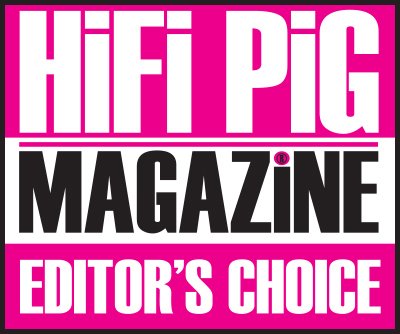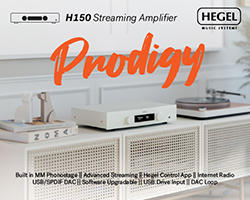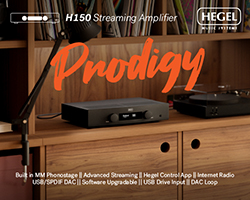ALLEGRO FLOW ONE AMPILFIER REVIEW
Allegro FLOW ONE amplifier is from Hungary and costs €13,000. It has a distinctive and unusual aesthetic but how does it sound? Stuart Smith takes a listen.
Hungarian brand Allegro was a completely new brand to me when they first got in touch and asked if we’d like to take a listen to one of their amplifiers, but as we love hearing about new (to us) brands in the audio world, and after a bit of research into who they were, we agreed – though they had to wait a good while for us to fit them into the somewhat hectic review schedule.

A distinctive wave pattern adorns the front, but no volume or control knobs or switches.
We already know Allegro are a Hungarian manufacturer based in Budapest, but reading a little further the company is headed up by Béla Teleki with them having represented brands such as Chario, Rega and WBT. Béla has been involved in HiFI retailing since 1998 with his first company being Agria Audio and his first own showroom using the Allegro Audio name opened in Eger in 2015 with a showroom opening in Budapest in 2018.
Béla told us that “FLOW by Allegro as a product brand has existed since 2017, and it was then that its carefully designed amplifier line gained its present, final form through a lot of research, experiments, trials, and tests. Product development has been in progress during this time. In the meantime, Béla’s wife, Andrea Ohár joined their family business full time in 2016.”
Béla continues “One of the individuals who greatly influenced our work is Miroslav Popovic of WAY Cables. His visit to Hungary in September 2021 and very positive feedback was very important to us. Another notable person evaluating our creation, among others, was Mario Marcello Murace, founder and creator of Chario Loudspeakers. He listened to FLOW One by Allegro and was fascinated by it.”
Béla says that he is convinced that listening to music can be learned and that hearing can be refined and says that this understanding energizes and encourages him. He now wants to show that music can provide unforgettable experiences and that a quality device can turn a living room into a concert hall. Clearly, Béla is passionate about music and the reproduction of music in the home.
BUILD AND FEATURES
OK, so this is certainly a very beautiful piece of audio equipment with a hand-polished Brazil-nut front cover that has a wave motif within it. This front panel certainly sets the FLOW 1 apart from the run-of-the-mill metal boxes that we see so often, but as well as looking like a very nice bit of furniture for the home (almost sculptural) the wave design also has meaning. I’ll quote the Allegro website here – “The design of the housing was inspired by Mihály Csíkszentmihályi, the world-renowned psychologist and his original concept of “flow” as, for instance, the wavy lines on the front attest to that. With the FLOW by Allegro Audio amplifier family, our intention was to conjure up that magical flow phenomenon in the soul of the listener that high-quality music is able to create. An unmistakable experience of the perfect moment.” Now the cynic in me suggests that that’s all marketing bumph, but the old hippy in me sort of likes the sentiment too. Whatever this integrated amp certainly looks very natural and organic and I really can see it taking pride of place in a home and not just stuck on, and hidden from view on a HiFi rack. You can get a high-gloss or piano-black front panel for extra dosh. And I’m guessing by it’s glossiness that we did indeed get the high-gloss version.
The amp arrived in a wooden crate, though I’m told consumer units come in more conventional cardboard packing. It’s large (W 440 x H 200 x D 430mm) and has a weight (25kg) to it that inspires confidence.
The only other accoutrement to the front panel is a round glass disc behind which a simple display shows input and volume, though this can be dimmed. There are no buttons and no volume knob! One thing I did notice when using the remote control to change the volume is that it stays at the volume you have it on until you let go of the volume button – you can increase it in steps (63 with 1dB intervals) by repeatedly pressing the volume button on the remote – quirky but not a major issue. Now, the fact that you cannot control the amp with a conventional volume knob (potentiometer) is not an accident and I asked Béla about this and got the following response “The input selector and volume software are completely custom developed. For improved sound quality, there are no potentiometers or other buttons on the amplifier and all functions can only be controlled from the remote control: volume, input selection, muting.” Now, this makes sense from a sound-quality perspective!
The back panel is very nicely spaced out with very good WBT NextGen speaker binding posts left and right and then four RCA inputs in the middle – there are no XLR/balanced inputs. The only other gubbins on the back panel are the IEC power inlet and main switch and then a fuse holder.
Inside this solid-state amp, though I didn’t open it up, Allegro uses UP-OCC monocrystalline cabling with the Class A/B design giving out 80W into 8Ohms and 140W into 4Ohms which should be enough grunt for most situations. The specs are at the end of this review. Béla tells me that the measurement of each component is very important and that they place great emphasis on “care, purity, and accuracy”. After assembly of each amplifier, they are measured and listening tests are carried out – yes, that’s for each amplifier.
Personally, I thought the FLOW ONE looked absolutely lovely on the rack and the wooden remote control was a very nice touch., however, I would have liked to have seen a conventional volume control, though I fully appreciate this would have made a dog’s dinner of the front panels rather pleasant aesthetic and I now understand that this is done for solid sonic reasons.

Around the back, there are high-quality connectors.
SOUND QUALITY
The amp was hooked up to our Diptyque Audio dp77 speakers which are a tad difficult to drive. The source was an Auralic Aries G1 with a Leema Libra DAC set to fixed output level. Cables were Tellurium Q, WAY and Atlas throughout and a LAB12 mains conditioner was also used on all components. I will make comment on the amp powering the Audiovector R6 loudspeakers later but this will not make up the larger part of the review, or it wasn’t supposed to be.
First off it was clear that the FLOW ONE and the dp77 are clearly a very good match and, as regular readers will know, this isn’t always the case being quite a difficult speaker to control properly, though when you do get it right they are fantastic. In fact, this is as big sounding as I’ve heard these speakers, with bass being deep and with everything else falling into place with ease and with a rightness to the music.
Motor City Drum Ensemble’s Nightfall had just the right amount of pace and (yes I’m going to say it) flow, where nothing seemed to be being forced, though bass on this track was certainly dominant, but not overly so. With that said about the bass, the synth sounds that come and go were properly positioned and the big cymbal splashes halfway through shimmered and hung in the air wonderfully. However, when that hollow Roland (I’m guessing) kick comes in you certainly know it’s there and that’s really something I wasn’t expecting given the look of this amp. If I’m honest, and we all do this with new kit, we build an expectation based on the looks of a product – I’d expected this to be all audiophiley and to have a pushed mid and upper-mid sound. I couldn’t have been more wrong!
Just to check that this wasn’t some kind of fluke I continued the techno vibe for quite some time with this amp, particularly enjoying DJ Stingray’s album Psyops for Dummies + Purge. The opening track is Disinformation and whilst there’s still that huge fat bass kick filling the room, the flanged (or phased, I don’t know) beats are easy to pull out of the mix and nothing gets missed. When the strings come into the left channel they soar and lift the track in soundstage height and in spirit. There’s also a constant synth line throughout this track that can easily get lost with everything else going on, but the FLOW ONE keeps everything separated and in place. Nothing seems overdone, though again I’m surprised by the bass heft coming out of these speakers when powered by this amplifier – it really is the best I’ve encountered with these loudspeakers.
I like to play techno on new kit as it’s a real workout and separates those products that are a bit of a one-trick pony from those that are more akin to those dancing Andalusian horses – or prancing ponies, as I like to call them. The FLOW ONE seems to be the latter – power, poise and agility in one beautifully turned out unit!
Neil Young’s Powderfinger off Live Rust shows me that the bass that was so palpable on the techno tunes I mentioned wasn’t perhaps the amp overly pushing the bass. With Young and Crazy Horse playing there was a sense of balance to the sound coming out of the speakers with nothing being overly pushed to the fore though. You certainly feel the kick drum on Cinnamon Girl which is fantastic and brings the whole thing together to feel live (it is, of course) and exciting. The mess of noise at the end of this track just isn’t a mess anymore and it’s clear what is playing and I heard little bits in this mess I’d not taken much notice of before. I cheated and looked up the price, and whilst it was more than I had initially guessed at €13K I wasn’t overly surprised given the quality of the sound I was hearing. Again, I would use control and speed as my main takeaways. The amp seems to be very transparent too, and there’s more a feeling that it’s the tune I’m hearing rather than anything the amp is adding, though there’s still a feeling of the bass being very much “there”. The same is apparent when I put the title track of Young’s Harvest on. Everything it laid before me and Young’s voice is projected into the room whilst the steel guitar comes and goes. The snare sounds extra snarey and the strum on the guitar sounds deliberate and stilted – what I’m saying, badly, is that small nuances in the recording come to the fore when this amp is in the chain. It’s almost as if it has all the nice things that a good valve amplifier brings to the party through the mid-band and tops and then with added oomph and well in the very deep bass, though I’m guessing some may not like this pronounced bass heft. Everything stops and starts on a pin with this amplifier and it’s about as natural sounding as you could want in the main – dynamic and nuanced. On Heart Of Gold, I sit up and take notice as the tune starts and sit enthralled through to the end. Harmonica sounds right and again there are little details I was made more aware of than I had been previously. Old Man is gloriously detailed and I stop taking notes and just listen to the tune. My only complaint here is that the sound is a little less three dimensional in height than I’m used to with our Merrill Thor and Krell amplifier on these speakers, which makes me want to take the amp into the big system and onto the Audiovector R6s…and so I did!

A look from the side of the amplifier.
An XLR input here would have been a great help here, though that is as much to do with the way our main room is set up for convenience. However, it would add a further degree of flexibility to the amplifier.
The first tune in the big room and using the LAB12 DAC Reference was The Streets’ Weak Become Heroes as it has a bass line and kick that play off each other and it can sometimes sound quite confused between the two. Here it’s easier to separate the two than I’ve ever heard in this system – that’s a bold statement – but accurate! The tunes play on and one of the things I jot down in my notes is that the sound is a touch more palpable than I’m used to and there are little details that are a smidge more apparent than usual. Whatever, it’s clear that this is a very, very good amplifier.
One of the tunes I play a lot comes up in Roon (Spiritualized’s I think I’m In Love (Chemical Brothers’ mix)) and I’m particularly drawn to a sound in the background that sounds like a sample of the vocal track cut up and played over – it’s subtle and way back in the mix for the most part, but here it seems easier to pull out – more separation isn’t the way to describe it, but it is more apparent. Now, there’s the possibility that this amp could be accused of being too revealing (can that even be a thing in the world of HiFi?) and I think it may be that with poorer ancillary kit ahead of it, it may expose weaknesses, though I have no way of confirming this!
Gil Scott-Heron and Brian Jackson’s Winter In America is an album I have used for years in reviews. The opening track is represented with huge space and air in and around the mix, though the main vocal is projected out into the room wonderfully. The tone of the electric piano is fully appreciable and the bass is fantastically easy to follow and feel. It’s no exaggeration to say that this is as good as I have heard this in this system. There is a realism and effortlessness to the way this amplifier gets the music across to the listener, and whilst it is highly detailed and nuanced it’s not at all fatiguing, or in any way too much. I know the name suggests it and I that I’ve used the term previously, but the music does “flow” effortlessly with this amplifier. The Bottle really is as detailed as I’ve heard it and there’s a tambourine (I think) used that I’ve not taken notice of much before but the FLOW brings this out in a way that it’s more noticeable, but not overly so – not sure that will make sense but it did make me sit up and take notice but without losing track of the tune.

Other colours are available.
I’ve perhaps given the impression that this amplifier sounds a tad overly exuberant in the bass department but I sincerely don’t believe this to be the case after extensive listening to loads of tunes from loads of different genres. What I think the FLOW has is an ability to present what it is given in an accurate, fast and yet hugely involving way to the speakers.
As I’m finishing off tying up my notes I’ve got District Sleeps Tonight by The Postal Service playing very quietly in the background and I can still hear loads of detail in the bubbling synths and drum machines and this is a good thing to hear. At this kind of level, I’d fully expect what was playing to be very much “not there” but I can’t help but take notice of the tune – it’s a cracker by the way. That’s an aside, but it does show that this amp is able to deliver realistic detail even at very low volume.
QUIBBLES
Remote volume is a bit quirky in how it works, but work it does.
There are no balanced XLR inputs that I’d have liked to have as it makes my life a lot easier, though I appreciate that for most this will not be an issue in any way.
The amplifier does dig deep in the bass department and this can come as a bit of a shock at first.
This is a line-level only amp and so no onboard phonostage or DAC – this latter point isn’t a major quibble as the amp is clearly stated as being a line-level integrated, but given that it’s very much a beautiful looking statement piece that is so aesthetically pleasing, it would be a shame to put less beautiful black boxes at its side. Perhaps Allegro plan to produce more products down the line!
CONCLUSION
Sometimes a bit of kit arrives at a time that’s a bit unfortunate for it and the Allegro FLOW ONE is one of those products. It arrived for review, or rather found itself in the systems, shortly after I’d just reviewed and rewarded highly, amplifiers by AVID and by LAB12. As such this puts me in a position where I’m acutely aware of the award that I give a product – give it a top award and it looks like I hand them out like disco biscuits at a rave, score it harshly and I end up being all the miserable buggers under the sun. As it is I have absolutely loved the time I have spent with the FLOW and whilst I have agonised over the award it gets, there’s absolutely no option, and with a clear conscience, other than to give it the Editor’s Choice award. It’s simply one of the best amplifiers I have heard at home. It’s natural-sounding but doesn’t try to push that naturalness artificially by forcing the mids and presence band to the fore.
However, the amplifier isn’t perfect and I want it to have XLR inputs and outputs, the looks will divide opinion and, given it’s a relatively unknown name, the resale value I likely to be lower than it would have been with a bigger name. If you can get over these (non) issues and concentrate on the sound this amplifier makes then you will (I think) absolutely love it.
Whatever music you play, the Allegro FLOW ONE plays it with a solid effortlessness that belies its relatively modest output and A/B design. It’s fast, detailed and hugely enjoyable.
I will be very sad to see this one go in the courier’s van!
AT A GLANCE
Build and Features:
Different enough to stand out as interesting
Not too different as to be outlandish
Fit and finish is excellent
Quality fittings used throughout
Included remote is nice and does all it needs to do, though it is vital!
Cabling inside is of good quality – unconfirmed but specified as such
Sound Quality:
Effortless power across the frequencies
Detailed and yet easy to listen to for long periods
Fast, quiet hugely satisfying to listen to
Excellent at low volumes as well as high
Value For Money:
It’s a lot of money to spend on a relatively unknown brand, but from a purely sonic perspective it offers good value for money when compared to the competition
Resale value is unknown
We Loved:
Realistic bass performance without it feeling pushed
An open and speedy delivery
Great at low and high volumes
We Didn’t Love So Much:
No XLR outputs (or inputs)
Design will divide opinion
It has to go back
Price: €13,000
Elevator Pitch Review: Made in Hungary the €13,000 Allegro FLOW ONE is an 80W (8Ohms) line-level (RCA) only integrated amplifier that intentionally has no physical controls, meaning source and volume can only be changed via the remote. It has an interesting aesthetic that will divide opinion but it is sonically where the FLOW ONE scores very highly. It has an effortless quality to its sound that impresses with its detail and speed. It is sonically balanced and with an open and hugely inviting feel to the way it plays whatever music you choose. I loved it!
Review Equipment: Diptyque Audio dp77 speakers, Auralic Aries G1 with a Leema Libra DAC. Cables were Tellurium Q, WAY and Atlas. LAB12 mains conditioner. Audiovector R6 loudspeakers, LAB 12 DAC Reference.

Stuart Smith
SPECIFICATIONS
| Power output: | 8 Ω – 80 W / 4 Ω – 140 W |
| Frequency Response: | 20Hz – 20kHz |
| THD + Noise Less than: | 0.06% |
| SNR (Signal Noise Ratio): | 96 dB |
| Audio inputs: | 4 RCA analog signal inputs |
| Audio outputs: | 1 pair of speaker outputs, right and left |
| Power consumption: | 400 W |
| Standby: | 75 W |
| Dimensions (mm): | W 440 x H 200 x D 430mm |
| Weight (net): | 25 kg |
| Finish: | Hand polished semi-matte brazil-nut front cover |

























































































































































































































